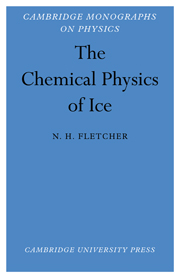Book contents
- Frontmatter
- Contents
- Preface
- Note on Units
- CHAPTER 1 The water molecule
- CHAPTER 2 Structure and energy of ordinary ice
- CHAPTER 3 Other forms of ice
- CHAPTER 4 Liquid water and freezing
- CHAPTER 5 Crystal growth
- CHAPTER 6 Thermal properties and lattice dynamics
- CHAPTER 7 Point defects
- CHAPTER 8 Mechanical properties
- CHAPTER 9 Electrical properties
- References
- Subject Index
CHAPTER 5 - Crystal growth
Published online by Cambridge University Press: 21 May 2010
- Frontmatter
- Contents
- Preface
- Note on Units
- CHAPTER 1 The water molecule
- CHAPTER 2 Structure and energy of ordinary ice
- CHAPTER 3 Other forms of ice
- CHAPTER 4 Liquid water and freezing
- CHAPTER 5 Crystal growth
- CHAPTER 6 Thermal properties and lattice dynamics
- CHAPTER 7 Point defects
- CHAPTER 8 Mechanical properties
- CHAPTER 9 Electrical properties
- References
- Subject Index
Summary
Ice crystals can grow in two simple distinct ways: either by the freezing of liquid water or by direct sublimation from the vapour phase. In each case the mechanisms which determine the rate and habit of growth are the transport of water molecules to the point of growth and their accommodation into the growing interface, together with the transport of latent heat away from this interface. Many different physical situations can occur, of course, but they are all controlled by these basic mechanisms.
If the system contains another component in addition to water, the situation can be much more complicated because crystal growth depends upon the transport of this component as well and there may also be competing processes occurring at the interface with the growing ice crystal. Some additional components, such as air in growth from the vapour, have a relatively small and simply understandable effect, but more complicated phenomena occur, for example, in the freezing of brine or sugar solutions. In this chapter we shall have very little to say about such cases but concentrate upon understanding the simpler systems.
Basic theory
The thermodynamic force driving any crystallization process is an excess of the chemical potential of molecules in the environment relative to its value in a bulk crystal. This excess may be specified as a supercooling, in the case of freezing, or as a supersaturation in the case of growth from the vapour or from solution.
- Type
- Chapter
- Information
- The Chemical Physics of Ice , pp. 104 - 129Publisher: Cambridge University PressPrint publication year: 1970
- 2
- Cited by



